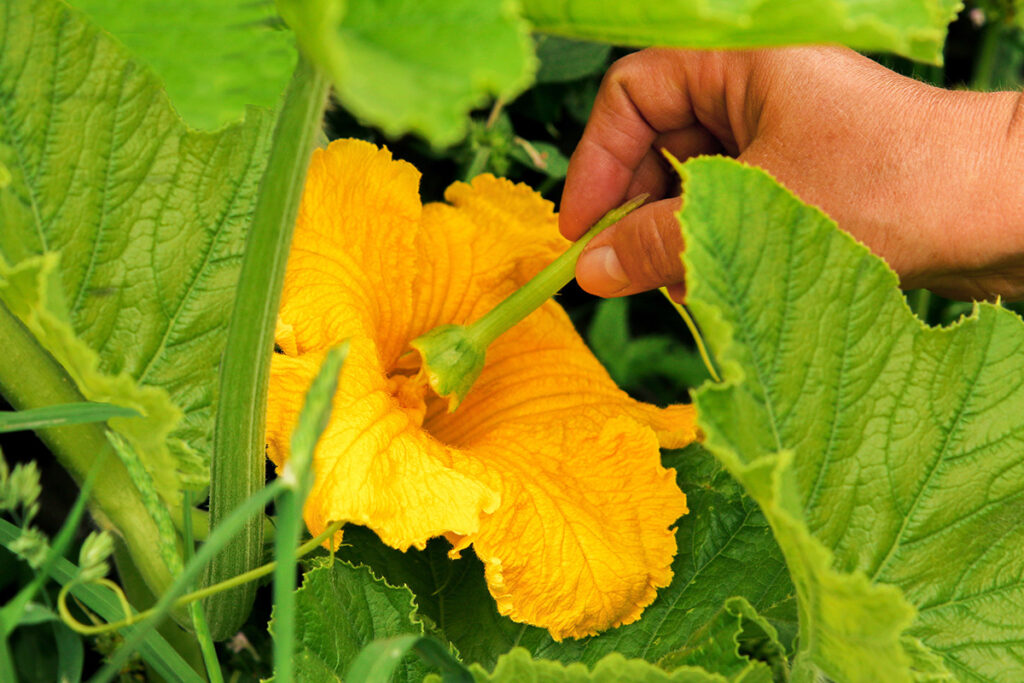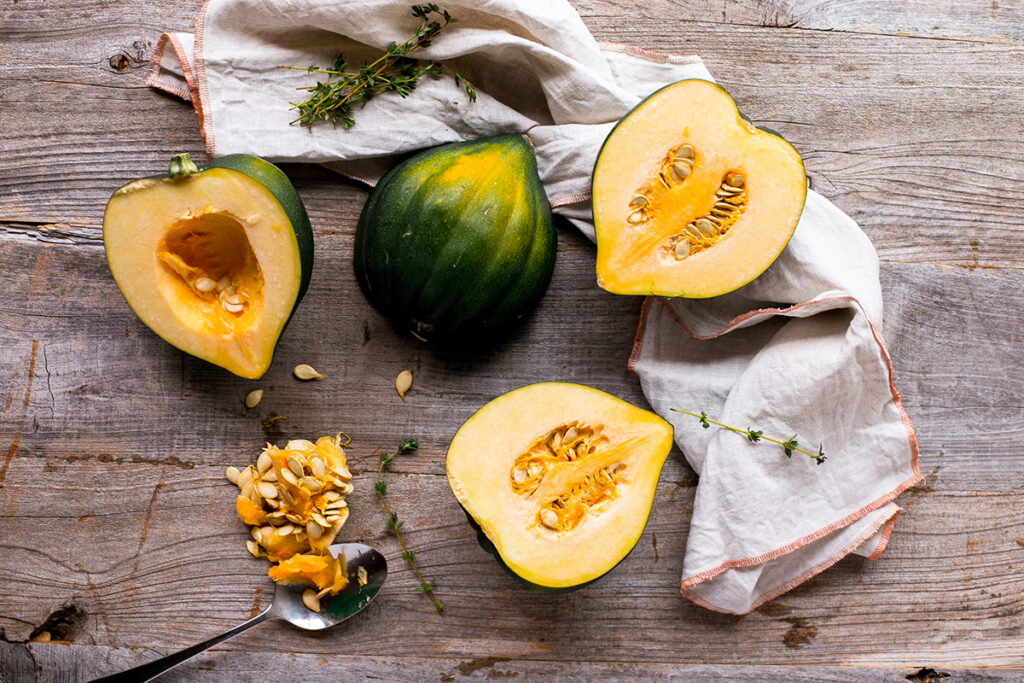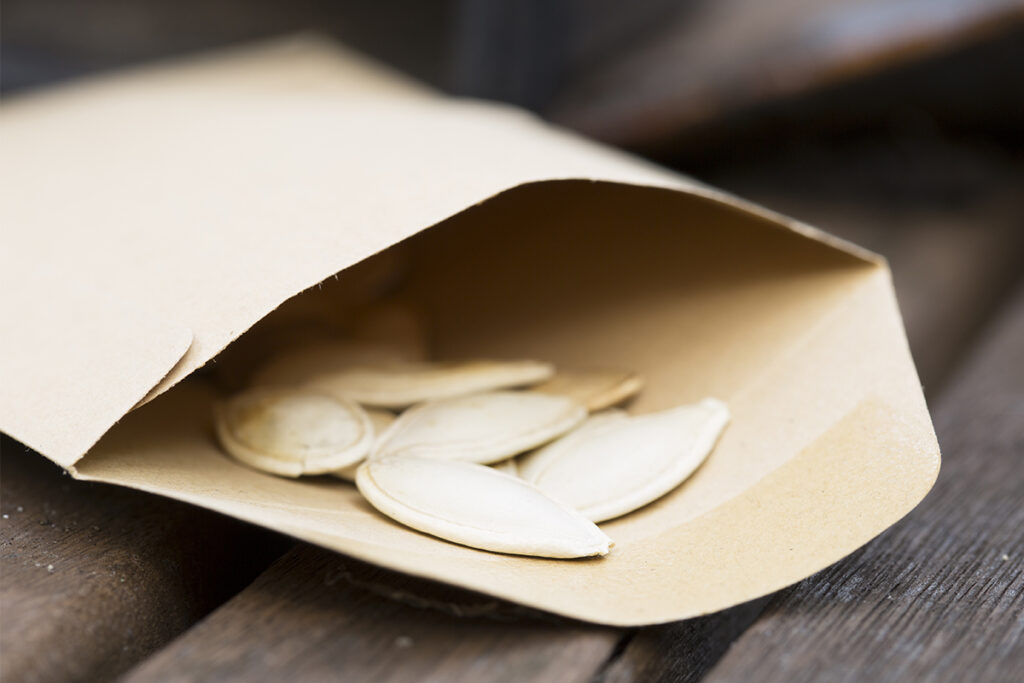
By Angelo Randaci, Earth’s Ally Horticulturist
Angelo’s passion for plants has led him to explore many areas of horticulture including research, grounds management, technical training, design and nursery management.
Many local markets and farms will offer an irresistible assortment of pumpkins and other gourds for purchase this fall. Not only are members of this family great in recipes but are a perfect way to add unique colors and textures to your usual fall display. You can easily use pumpkins and gourds creatively all the way through Thanksgiving if kept dry and kept from freezing.
Whether growing for food, ornament, or both, you can add to your gardening experience by saving seeds from these beautiful and tasty gourds. Read on to learn what types of seeds to save, how to ensure they are thoroughly pollinated, and how to save seeds from pumpkins, squash, and other gourds for planting next year.
F1 Hybrids
Cucurbits or the gourd family (Cucurbitaceae) include squash, pumpkin, zucchini, and some gourds. Varieties include heirlooms as well as F1 hybrids.
The question comes up often regarding saving F1 hybrid seeds, so let’s first look at F1 hybrids. F1 hybrids are bred for improved disease resistance, earlier flowers, different growth habits, flower color, or other variations that are unique from the original parent plant. But what is an F1 hybrid, and should I save seeds from them?
An F1 hybrid plant is created by the selective breeding of two different parent plants under controlled conditions to establish a pure line. The result is two parent plants that self-pollinate to produce plants that exhibit consistent traits without variants. Once this is accomplished (and it could take years), the two parent plants that are stable will breed true from generation to generation. When crossed, these two plants will produce an F1 hybrid. F1 stands for filial 1 or “first children”.
Should I collect seeds from F1 hybrids?
Collecting seeds from these hybrids will not produce an identical plant the following year but one with an unpredictable mixture of characteristics from the grandparent plants. Seeds may even be sterile. If you have a particular F1 hybrid that you like, you will need to purchase seeds every year. If you want to save your own seeds, acquire heirloom seeds.
Heirloom Seeds
Unlike hybrids, heirloom seeds are old varieties that have been passed from gardener to gardener before 1951 (when hybridization became popular). These varieties are open-pollinated, meaning that they are fertilized by insects, birds, bats, wind, or rain. Seeds collected from open-pollinated plants will not produce hybrids.
Avoid Cross-Pollination
Cucurbits are notoriously promiscuous and will readily cross-pollinate. Cross-pollination is also possible with other members of the same species. For example, cross-pollination can happen between squashes, gourds, and pumpkins belonging to the same species, Cucurbita pepo.
For this reason, do not grow pumpkins near other pumpkin varieties or cucurbits such as squash and gourds because they too can cross-pollinate and while this won’t affect the quality of this year’s fruit, the saved seed may result in distorted shapes and poor flavor. Regardless of what fruits you end up with, you will have lost your original heirloom variety.
The best way to know for sure that you are preserving your heirloom variety is to pollinate your female flowers by hand.
To Pollinate By Hand
Identify the male and female flowers: Members of this family have separate male and female flowers on the same plant. The female flowers have a bulbous area (ovary) at the base of the stem. Male flowers are borne straight off the stem with no swelling at the stem base.
Cover both the male and female flowers either the night before the flowers open or early morning before pollinators arrive with cheesecloth or similar material. Do this to keep pollinators from bringing in pollen from other plants. You can also gather the petals and use a clothespin to clamp the petals together to keep pollinators out.
The best time to pollinate is early morning when flowers first open. Uncover the male flower and collect pollen using a soft-bristled artist’s brush or cotton swab. Uncover the female flower and transfer the pollen onto the center of the female flower (stigma), gently brushing over each segment until thoroughly covered. You can also pollinate the female by removing the male flower’s petals to expose the pollen parts (stamen) and then gently rubbing the pollen onto the female flower’s stigma. Discard the male flower.

Once pollinated, cover the female flower again with your cheesecloth to keep pollinators out, or bring the petals together and close them with a clothespin. You can remove the cheesecloth a few days later.
How To Save And Store Seeds From Pumpkins, Squash, And Gourds
Remove seeds from a mature pumpkin, squash, or gourd. Decide how many seeds you want for next year and save two or three times more than you need to make sure you have backup seeds for next season. Members of this family are usually planted in groups of 4 or 5 seeds together in mounds with mounds spaced 4 or 5 feet apart. Keep this in mind when determining the number of seeds to save.
Select the largest, best-looking seeds discarding the small, poorly formed, or cracked seeds. Place them immediately in a pan of water and remove as much of the fleshy pulp as possible. Then place the seeds in a colander under running water to remove any left-over pulp.

Line a baking tray with wax paper and spread your seeds in a single layer. The wax paper helps keep the seeds from sticking to the pan. Place in a cool, dry area until completely dry. Once they are completely dry, sort through them and discard any with mold or mildew. Label and place them in an envelope. Store seeds in a cool, dry place until planting time.

Pumpkins, squash, and other gourds can be prone to fungal and bacterial diseases such as powdery mildew. To keep your harvest safe, check out Earth’s Ally Disease Control as a preventative treatment–or as a curative option if powdery mildew has already started to impact your crop.
We’d love to hear how you’re using Earth’s Ally Disease Control. Share your experience and stay connected with the #EarthsAlly community on Facebook, Instagram and Twitter for access to our latest blog posts, giveaways and exclusive promotions.
